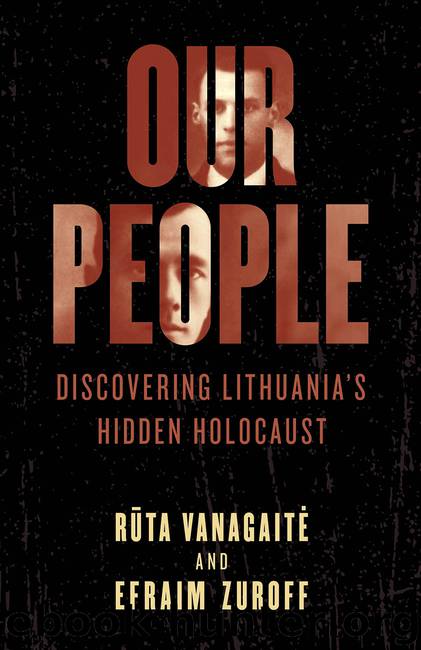Our People by Rūta Vanagaitė & Efraim Zuroff

Author:Rūta Vanagaitė & Efraim Zuroff
Language: eng
Format: epub
Publisher: Rowman & Littlefield Publishers
Published: 2019-12-31T00:00:00+00:00
The poet was writing about the Lithuanian partisans fighting the Soviets after the war, not about murdered Jews. It was probably just a coincidence that he mentioned Einstein, a Jew. It’s only a coincidence that sixteen-year-old Jews, future Einsteins, were murdered in 1941 by Lithuanians no older than they were. Not Galileos.
We go to the city center of Ukmergė and enter the local museum, where we ask about the Holocaust, and about Pivonija Forest. One of the workers points us toward an exhibition panel about the Holocaust, prepared thanks to funding from the International Holocaust Remembrance Alliance. There are a few photos and the traditional requisite text, the same sort as the one at the museum in Švenčionys and in the pamphlets. The Jews were arrested, transported, and murdered. Who arrested them? Who murdered them? What’s the difference? After all, it happened long ago. And in the final analysis, is this really part of Ukmergė’s history?
Efraim: On the third floor there is an entire section devoted to the history of the Jewish community of Ukmergė that was created with the support of the International Holocaust Remembrance Alliance (IHRA). It describes the Holocaust as follows: On August 18–19 and September 5, 1941, more than 6,354 people were murdered in Pivonija Forest near Ukmergė, which was one of the favorite places of the town’s residents. But there is no mention of who did it. The most outrageous detail in this museum is the fact that this special corner was created by IHRA, so, in fact, IHRA is spending money to hide the crimes of the Lithuanians, a phenomenon which is so typical here. We are talking about a city in which more than eight thousand Jews were murdered.
Rūta: I think that the best Holocaust education is not putting up one or two abstract sentences in a museum, but to put a plaque on every building which was used for guarding people, during the Holocaust. On a private garage in Kavarskas where the Jews were held, as well as at Vaitkuškis manor (which is currently private property), there should be signs about what happened there during the Holocaust. In ten years, nobody will know anything. Even now, nobody knows.
The city of Ukmergė, like all the other Lithuanian cities, wants to have a heroic history. It has a monument recently built for one of the postwar heroes. So we are trying to find the square which the city of Ukmergė recently renamed in honor of an anti-Soviet partisan named Juozas Krikštaponis. None of the locals seem to know where the square is, or the statue, or who Krikštaponis was. They only know that there is a statue to which the archbishop of Lithuania, Monsignor Svarinskas, used to come to pay his respects. And that’s the one.
Next to Vytauto Street near the public library there is a huge monument with a cast bas-relief of the hero. Krikštaponis is famous for being the nephew of Lithuanian president Antanas Smetona, but more infamous for having served the Nazis loyally in the Impulevičius battalion before becoming a partisan.
Download
This site does not store any files on its server. We only index and link to content provided by other sites. Please contact the content providers to delete copyright contents if any and email us, we'll remove relevant links or contents immediately.
| Afghan & Iraq Wars | American Civil War |
| American Revolution | Vietnam War |
| World War I | World War II |
Waking Up in Heaven: A True Story of Brokenness, Heaven, and Life Again by McVea Crystal & Tresniowski Alex(37017)
Empire of the Sikhs by Patwant Singh(22184)
We're Going to Need More Wine by Gabrielle Union(18081)
Hans Sturm: A Soldier's Odyssey on the Eastern Front by Gordon Williamson(16751)
Leonardo da Vinci by Walter Isaacson(11914)
The Radium Girls by Kate Moore(10915)
Educated by Tara Westover(7074)
Tools of Titans by Timothy Ferriss(6963)
How to Be a Bawse: A Guide to Conquering Life by Lilly Singh(6700)
The Last Black Unicorn by Tiffany Haddish(5080)
Permanent Record by Edward Snowden(5007)
The Rise and Fall of Senator Joe McCarthy by James Cross Giblin(4852)
Promise Me, Dad by Joe Biden(4454)
The Wind in My Hair by Masih Alinejad(4427)
The Crown by Robert Lacey(4113)
A Higher Loyalty: Truth, Lies, and Leadership by James Comey(4038)
The Iron Duke by The Iron Duke(3650)
Joan of Arc by Mary Gordon(3268)
How to be Champion: My Autobiography by Sarah Millican(3192)
